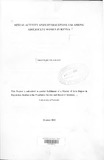| dc.description.abstract | The objective of this study was to examine how various socio-economic, sociocultural
and demographic variables interact to affect adolescent sexual behaviour and
how these interactions further affect contraception behaviour. The data used was
drawn from the Kenya Demographic and Health Survey (KDHS, 1998).
The study used logistic regression, cross-tabulation and chi-square methods of
analysis. Chi-square statistics were used to determine the significance of the
association between selected demographic, socio-economic and cultural variables and
sexual activity and contraceptive use.
The findings of the study have underscored the importance of socio-economic,
demographic and cultural factors as far as adolescents' sexual behaviour and
contraceptive use are concerned. The results provide further evidence of these
characteristics, in shaping the lives of adolescents particularly their knowledge about
adverse consequences of early sexual intercourse, pregnancy, and other reproductive
health issues such as fertile days and sexually transmitted infections.
Findings of the study revealed that female adolescents, especially those in the rural
areas, engage in sexual intercourse at a very early age. The mean age for female
adolescents aged 15 - 19 years was approximately 9 years. Concerning the sexual
partners, majority professed that they had regular partners but contraceptive use was
found to be low. However, contraceptive use generally increased with an increase in
age.
• Acknowledge that adolescent girls' lives are often governed by harmful,
culturally sanctioned gender rules imposed by males, parents, and other elders and
perpetuated at times by girls themselves.
• Expand girls' social participation, schooling, and econormc opportunities,
understanding that these are basic entitlements and that they frame girls,
reproductive behaviour.
• Recognize that a large proportion of adolescent girls are already Wives and
mothers, who need support and investment at least as much as do their unmarried
female peers. | en |

